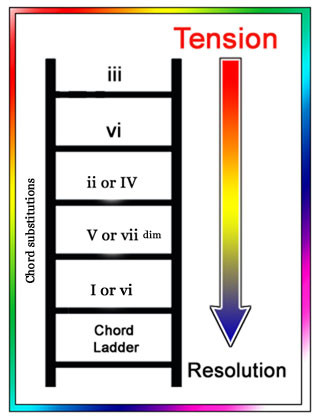Guitar chord progressions are the backbone of music, providing structure and emotional depth to songs. The sequence of chords determines the mood and feel of a piece, influencing how listeners connect with the music. A Guitar Progressions Chart is an invaluable tool for guitarists of all levels, especially beginners, to grasp these fundamental musical patterns.
What are Guitar Chord Progressions?
Simply put, a chord progression is a series of musical chords played in a specific order. These sequences aren’t random; they are derived from musical scales within a chosen key. Think of scales as families of notes that naturally sound good together. Chords built from these scales create harmonious progressions.
In musical notation, we often use Roman numerals to represent chords within a scale. The most common are the I, IV, and V chords, which are typically major. Chords denoted as ii, iii, vi, and vii are usually minor.
 Sample three chord guitar progression
Sample three chord guitar progression
For example, a fundamental progression is the I-IV-V. In the key of C major, this translates to C major (I), F major (IV), and G major (V). This simple progression is the foundation of countless songs across genres.
Decoding the Guitar Progressions Chart
A guitar progressions chart visually organizes chord progressions, often displaying common chord sequences across different keys. These charts are designed to be user-friendly, enabling guitarists to quickly identify chords that work well together.
 Chord progression chart all keys
Chord progression chart all keys
Typically, a guitar progressions chart will list keys (like C, G, D, etc.) and then show the corresponding I, IV, V chords (and often others) for each key. Understanding how to read these charts unlocks the ability to play a vast number of songs and even start writing your own.
The Chord Ladder and Musical Tension
Imagine a “chord ladder” to understand the emotional impact of progressions. Moving up the ladder creates musical tension, while moving down towards the “tonic” chord (the I chord) provides release.
 guitar chord ladder
guitar chord ladder
Chord progressions utilize this push and pull of tension and release to create engaging and emotionally resonant music. The further you move away from the tonic, the more tension you build, and the return to the tonic provides a satisfying resolution.
Expanding Your Chord Vocabulary: Chord Substitutions
As you become more comfortable with basic progressions, you can explore chord substitutions to add complexity and flavor. A guitar progressions chart might also include common substitutions, showing chords that can be interchanged because they share similar notes and harmonic functions.
 Guitar chord ladder with chord subsitutions
Guitar chord ladder with chord subsitutions
For instance, the vi chord can often substitute for the I chord in certain contexts, creating a minor feel. Experimenting with substitutions, guided by a comprehensive guitar progressions chart, can greatly enhance your songwriting and improvisational skills.
The Power of Simple Progressions
Many hit songs are built upon surprisingly simple chord progressions, with the I-IV-V being one of the most popular and successful. Don’t underestimate the power of these fundamental sequences. Mastering basic progressions using a guitar progressions chart is the first step to unlocking a world of musical possibilities on the guitar.
By utilizing a guitar progressions chart, beginner guitarists can quickly learn and apply these essential musical building blocks, paving the way for more advanced playing and songwriting endeavors.
